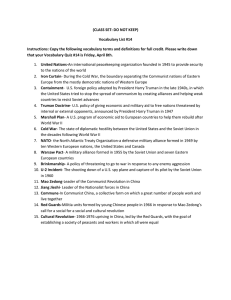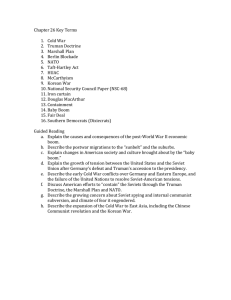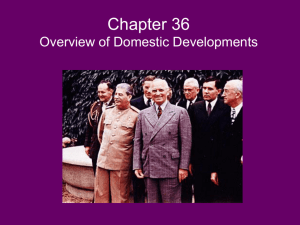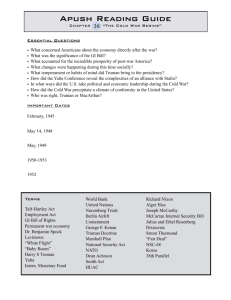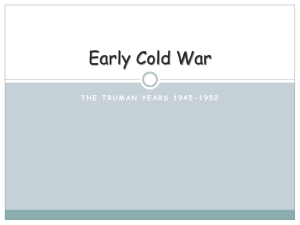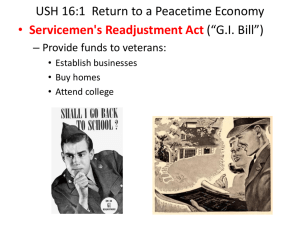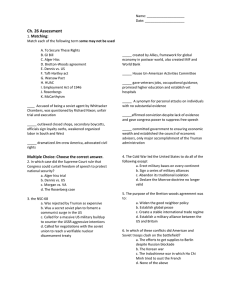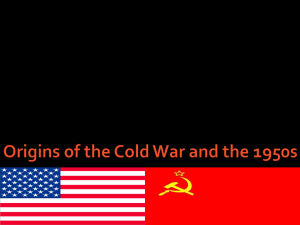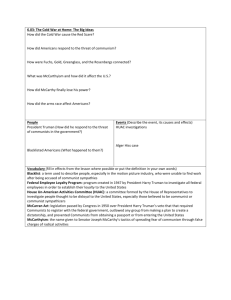Mr. Walter US History 2 The Truman Years: Student
advertisement
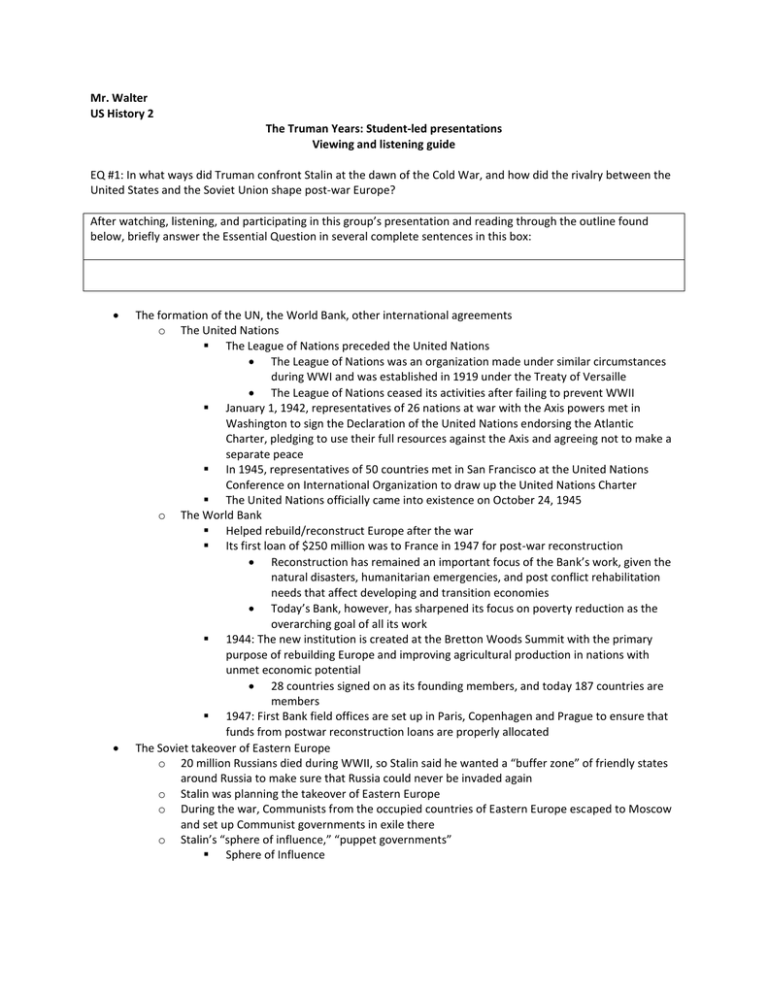
Mr. Walter US History 2 The Truman Years: Student-led presentations Viewing and listening guide EQ #1: In what ways did Truman confront Stalin at the dawn of the Cold War, and how did the rivalry between the United States and the Soviet Union shape post-war Europe? After watching, listening, and participating in this group’s presentation and reading through the outline found below, briefly answer the Essential Question in several complete sentences in this box: The formation of the UN, the World Bank, other international agreements o The United Nations The League of Nations preceded the United Nations The League of Nations was an organization made under similar circumstances during WWI and was established in 1919 under the Treaty of Versaille The League of Nations ceased its activities after failing to prevent WWII January 1, 1942, representatives of 26 nations at war with the Axis powers met in Washington to sign the Declaration of the United Nations endorsing the Atlantic Charter, pledging to use their full resources against the Axis and agreeing not to make a separate peace In 1945, representatives of 50 countries met in San Francisco at the United Nations Conference on International Organization to draw up the United Nations Charter The United Nations officially came into existence on October 24, 1945 o The World Bank Helped rebuild/reconstruct Europe after the war Its first loan of $250 million was to France in 1947 for post-war reconstruction Reconstruction has remained an important focus of the Bank’s work, given the natural disasters, humanitarian emergencies, and post conflict rehabilitation needs that affect developing and transition economies Today’s Bank, however, has sharpened its focus on poverty reduction as the overarching goal of all its work 1944: The new institution is created at the Bretton Woods Summit with the primary purpose of rebuilding Europe and improving agricultural production in nations with unmet economic potential 28 countries signed on as its founding members, and today 187 countries are members 1947: First Bank field offices are set up in Paris, Copenhagen and Prague to ensure that funds from postwar reconstruction loans are properly allocated The Soviet takeover of Eastern Europe o 20 million Russians died during WWII, so Stalin said he wanted a “buffer zone” of friendly states around Russia to make sure that Russia could never be invaded again o Stalin was planning the takeover of Eastern Europe o During the war, Communists from the occupied countries of Eastern Europe escaped to Moscow and set up Communist governments in exile there o Stalin’s “sphere of influence,” “puppet governments” Sphere of Influence As the Red Army drove the Nazis back, it occupied large areas of Eastern Europe and Churchill in the so-called percentages agreement which agreed that Eastern Europe could be a Soviet “sphere of influence” In the countries that the Red Army “liberated”, communist-dominated governments took power The Communists made sure that they controlled the army, set up a secret police force, and began to arrest their opponents By 1949, all the governments of Eastern Europe, except Yugoslavia, were hard line Stalinist regimes o Poland, Bulgaria, Romania, Albania, Yugoslavia, etc. Poland: (1947) Stalin had promised to set up a joint Communist/non-Communist government at Yalta, but then he invited 16 non-Communist leaders to Moscow and arrested them. Thousands of non-Communists were arrested, and the Communists won the 1947 election Bulgaria: (1945) In the 1945 elections, a Communist-led coalition was elected, but the Communists executed the non-Communists Romania: (1947) In the 1945 elections, a Communist-led coalition was elected to power. The Communists gradually took over and in 1947 they abolished the monarchy Albania: (1945) The Communists immediately took power Yugoslavia: the only country that wasn’t under Communist regime up until 1949 Problems with the occupation of Germany among the 4 nations o The US, Great Britain, the Soviet Union, and France took part in a joint occupation of the German state o The Allied Powers agreed to share the responsibility of administering Germany and its capital, Berlin, and each took responsibility for a certain portion of the defeated nation o This arrangement ultimately evolved into the division of Germany into a Western and Eastern sector, thereby contributing to the Cold War division of Europe Stalin suggested that Germany be divided so that it could not rise to its former strength to threaten European peace and security again o There was a lot of distrust between the US and the Soviet Union o The Soviet Union stripped its sector of Germany of manufacturing equipment in an effort to garner partial payment for wartime remittances, further stifling the reemergence of a strong German economy o In the western sector, the US soon grew concerned about the economic costs of a Germany completely dependent upon the US so they began investing in German industries o By 1946, the US and Great Britain merged their occupation zones, and in 1947 the US Government began a massive aid program under the Marshall Plan, which pumped dollars and goods into Europe to aid in recovery o The Soviet Union prevented the countries along the Soviet border in Eastern Europe, many of which had experienced the rise of communist leadership in the wake of the war, from taking part in the arrangement o By 1948, the Western Allies began the project of pulling their occupation zones together for the sake of rebuilding - a project that the Soviet Union, still worried about a Germany threat to its security, wished to prevent. o The Soviet Union never accepted terms that the US or Great Britain suggested about reuniting Germany o In June of 1948, the Soviet Union took action against the Western policies by blocking all road access between West Germany and West Berlin, effectively cutting off the city’s occupation zones from the British, French, and American forces responsible for maintaining them As a result, the US assisted by British and French, supplied West Berlin entirely by air, landing planes filled with food, clothing, and coal for heat nearly every minute o The blockade and airlift contributed to cementing the division of Germany and Europe into East and West In 1949, the occupying powers in both East and West Germany replaced their military governors with civilian leaders, and the occupations ended officially in the mid-1950s Even so, both sides retained a strong interest in Germany, and the country and its capital remained divided throughout the Cold War Reunification finally took place in October of 1990 George Kennan’s Telegram- February 22, 1946 o He was the American “charge d’affaires” in Moscow. o He sent an 8,000-word telegram to the Department of State, and they detailed his opinions on the Soviet Union and the U.S. policy towards them. o He was one of the U.S. diplomats that helped establish the first U.S. embassy in the Soviet Union. Despite having good relations with the Russians, his views on the communist country (the way they ran their country) was very negative. The telegram was where when he expressed his true feelings, and this was less than a year after Roosevelt’s death. o In the telegram, Kennan stated: He did not believe that the Soviet Union could peacefully coexist with the West due to the Soviet Union's “insecurities.” Due to this, the Soviet Union were always suspicious of other countries, and he said that they felt like they could only feel secure if the country had total power. He also believed that the Soviet Union would try and increase their sphere of influence, and he said that Turkey and Iran were the most troublesome areas. He also said that the Soviet Union would try and weaken Western powers on “colonial backward, or dependent people.” Lastly, he believed that, although the Soviet Union wanted to do these things, they would back down if a force stopped it. He wanted America to be that force. o Overall, America took a tougher stance and begin relying on military and economic “muscle” instead of just focusing on diplomacy with the Soviets. o Kennan’s belief on strong resistance against the Soviet Union was the basis of America’s Cold War diplomacy through the next two decades. o After writing this, he became the U.S. Ambassador for the Soviet Union. o http://www.history.com/this-day-in-history/george-kennan-sends-long-telegram-to-statedepartment Churchill’s Iron Curtain speech- March 5, 1946 o It is considered to be Churchill’s (former Prime Minister) most important speech as a leader of the opposition in Parliament. o He expressed concern for the Soviet Union’s expansion in Eastern Europe. o http://www.fofweb.com/NuHistory/default.asp?ItemID=WE52 o “From Stettin in the Baltic to Trieste in the Adriatic, an iron curtain has descended across the continent.” o This was known as one of the beginning steps of the Cold War. He gave the speech in Fulton, Missouri with President Truman by him. o After saying good things about America, he suggested a “closer” relationship with Great Britain in regards to the post-war world. o He also warned against the plans of the Soviet Union to expand their nation. o Comparing this to the appeasement of Hitler, he stated that the Soviet Union respects and admires strength while they have no respect for weakness. o Americans responded well to the speech, but they did not respond well to the idea of a closer relationship with Great Britain because they knew that Great Britain was falling apart. o Joseph Stalin, leader of the Soviet Union, did not respond well to the speech, and he implied that it could cause war. o The phrase “iron curtain,” became popular during the Cold War, and it represented the physical and ideological that divided Europe during the Cold War. o http://www.history.com/this-day-in-history/churchill-delivers-iron-curtain-speech ·The Truman Doctrine and containment; Greece and Turkey civil wars The Truman Doctrine- March 12, 1947 President Truman stated that the United States would provide “political, military, and economic assistance to all democratic nations under threat from external and internal authoritarian forces.” Overall, the Truman Doctrine changed the way the U.S. had their foreign policy. Previously, the U.S. tended to withdraw themselves more from foreign conflicts. With the Truman Doctrine, they had the possibility in involving themselves in foreign conflicts. This speech came about after the British government announced that they were no longer providing assistance to the Greeks that were fighting against the Greek Communist Party. Congress was asked to provide assistance to Greece and Turkey, which was another country going through the same thing. Congress was worried that the Soviets were supporting the Greek government, and they were worried that they would have influence in Greek policy. In reality, Stalin resisted providing support in Greece. Other reasons why the President Truman decided to help the Greece and Turkey o The Soviet Union did not remove their troops from Northern Iran o The Soviet Union tried to pressure the Iranian government into granting them oil concessions while “supporting” and/or stirring up trouble by “fermenting” support of annexation Azerbaijani separatists in Northern Iran o The Soviet Union tried to force the Turkish government into granting them base and transit rights through the Turkish Straits o The Soviet government rejected of the Baruch plan, an American proposal, for international control over nuclear weapons and energy. For these reasons, Truman knew that there would not be peaceful post-war interactions with the Soviet Union. Truman stated that America should give the money because a communist victory would undermine the political stability of Turkey and the Middle East. He also said America also had the duty of helping “free people” because a communist victory would be a threat to American security. Truman said that the United States could not watch free democratic countries be taken over by communism. Basically, the goal was to “preserve political integrity of democratic nations in the interest of the United States.” http://history.state.gov/milestones/1945-1952/truman-doctrine EUROPEAN PROTECTION/RECOVERY The Marshall Plan (European Recovery Program) o The need for the Marshall Plan showed itself in the aftermath of WWII. Every major power in the world other than the US was in shambles and the Marshall Plan was formulated with the initiative of aiding Europe before the Soviets can come in and spread ideas of Communism. o Including Germany, 16 nations became part of the ERP and were assisted through the Economic Cooperation Administration of the US. Europe received almost $13 billion in aid, first directed to shipping food, staples, fuel, and machinery from the US to Europe. However, this money was later directed to investing in the industrial capacity in Europe, making them more efficient. Funding ended in 1951 From 1948 through 1952, US had successfully helped European nations to recover economically at an unprecedented rate. The plan had led to the North Atlantic alliance. Economic prosperity led by coal and steel industries helped to shape the European Union, a union of 28 member states located primarily in Europe. The Berlin Airlift o After the end of WWII, Germany was split between the Allied Nations and the Soviet Union. Berlin itself, though it was in Soviet territory, was also split into two parts, with West Berlin being the Allied Nations’ and East Berlin being the Soviet Union’s. What the Soviet Union was doing to achieve Berlin was to cut traffic to and from West Berlin and to starve the population and cut off the civilians’ businesses. The Americans had responded by performing a daily airlift that dropped food and supplies into West Berlin. Lasted until the September of 1949. Soviets closed to blockade on May 12, 1949. The founding of NATO o North Atlantic Treaty Organization - signed by twelve nations, saw the US accept the lead in the free world’s resistance to Communist aggression. Leading roles - Senator Vandenberg, General Marshall of the US, British Ernest Bevin, Canadian Lester Pearson. o The Treaty bound the countries to treat an attack against one as an attack against all - US, Great Britain, Canada, France, the Netherlands, Belgium, and Luxembourg - JULY 1948. o TRuman described the treaty as a “shield against aggression and the fear of aggression - a bulwark which will permit us to get on with the real business of government and society, the business of achieving a fuller and happier life for all our citizens.” o APPROVED JULY 21st The National Security Act-1947 o This was a huge restructuring of the government’s military and intelligence agencies following the Cold War o It established the framework for foreign policy for the next 40 plus years of the cold war o It had three major parts It unified the nations military establishment by bringing together the navy department and war department under a new department of defense. It established the national security council. Their purpose was to sift through the flow of diplomatic and intelligence information in order to provide the president with brief but detailed reports. Finally, it set up the central intelligence agency (CIA). It replaced the central intelligence group which was established in 1946. However, the central intelligence agency not only gathered information but they also carried out covert operations in foreign nations The Soviet atomic bomb; Truman’s development of the H-bomb Union detonated an atomic bomb at their test site in kazakhstan also known as the hell bomb he sought advice from atomic energy commission three years earlier on january 31st 1950 that truman publicly announced that had directed the atomic energy commission to proceed with the development of the Hbomb o NSC-68(National Security Council Report 68) o o o o o It was a 58 page top secret policy report instituted by the united states national security council Shaped US foreign policy It was created with input from the defense department, the state department, the CIA, and other agencies The report starts off by noting that america is facing an entirely new world According to the report the US should pursue a policy of containing soviet expansion. o NSC-68 recommended that the US embark on rapid military expansion of conventional forces and the nuclear arsenal, including the developement of the new H-bomb EQ #2: How did the international community deal with the legacy and the aftermath of The Holocaust? What steps were taken to bring about justice and to help the survivors rebuild their lives? After watching, listening, and participating in this group’s presentation and reading through the outline found below, briefly answer the Essential Question in several complete sentences in this box: The Nuremberg Trials (PUNISH THE BAD GUYS) 1945-1949 to bring Nazi war criminals to justice 13 trials in Nuremberg, Germany Nazi party officials and high-ranking military officers, German industrialists, lawyers, and doctors were put on trial both civilian and military officers could be accused of war crimes 3 different types of crime o crimes against peace planning, preparing, starting or waging wars of aggression or wars in violation of international agreements o war crimes violations of customs or law of war which includes improper treatment of civilians and prisoners of war o crimes against humanity murder, enslavement, or deportation of civilians or persecution on political, religious or racial grounds Hitler wasn’t brought to trial because he committed suicide before The Allies eventually established the laws and procedures for the trials with the London Charter of the International Military Tribunal (IMT) o issued on August 8, 1945 Trials and People convicted of crimes o Trial of Major War Criminals the best-known November 20, 1945 - October 1, 1946 trials had prosecutors and defense attorneys (chosen by the people put on trial), but the decisions were made by a panel of judges rather than a jury or a single judge each of the 4 Allied powers supplied two judges (a main and an alternate) 24 individuals and 6 Nazi organizations were indicted multiple people committed suicide before they were able to be put on trial all but 3 found guilty 12 sentenced to death 1 was absent from trial the rest were given up to 10 years in prison 10 were executed by hanging o Subsequent Trials (1946-49) 12 additional trials 185 indicted 12 death sentences 8 life in prison 77 prison terms of varying length different from first trial because they were conducted before U.S. military courts rather than the international court (because of differences among the Allied powers) accused crimes included: medical experiments on war prisoners slave labor stealing from occupied countries violence against concentration camp inmates o Adolf Eichmann fled the country after the war and was found in 1961 in Argentina. He was then hanged as punishment for his crimes. controversial at the time now regarded as a milestone toward the establishment of a permanent international court and an important precedent for dealing with later instances of genocide and other crimes against humanity · Displaced Persons Act From 1945 to 1952, more than 250,000 Jewish displaced persons (DPs) lived in camps and urban centers in Germany, Austria, and Italy. These facilities were administered by Allied authorities and the United Nations Relief and Rehabilitation Administration (UNRRA). · Founding of Israel (FINDING A PLACE FOR PEOPLE TO GO) <<Problems>> Although the United States supported the Balfour Declaration of 1917, which favored the establishment of a Jewish national home in Palestine, President Franklin D. Roosevelt would not intervene without consulting both the Jews and the Arabs in that region. From WWI and on, the British controlled Israel under the Mandate System and under the name Mandatory Palestine (until May 1948) It opposed both the creation of a Jewish state and an Arab state in Palestine as well as unlimited immigration of Jewish refugees to the region. Great Britain wanted to preserve good relations with the Arabs to protect its vital political and economic interests in Palestine. Zionists - people fighting to return to the holy land (create Israel) Everybody wants control of this area because every religion has ties to areas in this country. <<Under Truman>> In October 1946, Truman publicly declared his support for the creation of a Jewish state. Throughout 1947, the United Nations Special Commission on Palestine examined the Palestinian question and recommended the division of Palestine into a Jewish and an Arab state. o That recommendation was delivered and planned to adopt Partition Resolution and officially divide Palestine into Jewish and Arab territories once the British mandate expired. o Obvious tension between the Arabs and the Jews; currently (2013), population 20.7% Arab and 75.3% o May 14, 1948 declared EQ #3: How did the Cold War transform Asia in the post-war era? What steps did Truman take to confront and contain Communism in that part of the world? After watching, listening, and participating in this group’s presentation and reading through the outline found below, briefly answer the Essential Question in several complete sentences in this box: Truman and the Dawn of The Cold War in Asia suggested topics: · U.S. Occupation of Japan and MacArthur/US-Japanese Security Treaty after WWII, Japan was occupied by the allied powers the San Francisco peace treaty was signed in september 1951, came into force in april 1952, and ended the occupation On VJ day, Truman appointed general MacArthur as supreme commander for the allied powers (SCAP) to supervise the occupation of Japan SCAP was given direct control of the main islands of Japan and the surrounding islands, and the outlying possessions were divided amongst the allied powers japanese officials met MacArthur in August and discussed his plans for occupation MacArthur made several laws: no allied personnel were allowed to assault the japanese people, eat the scarce food on september 2nd, japan formally surrendered with the Japanese Instrument of Surrender Truman approved “US Initial Post-Surrender Policy for Japan”-this set aside two objectives: eliminating Japan’s war potential, and turning Japan into a western style nation with pro- American orientation MacArthur first set up a food distribution network he then brought in troops to tokyo outcomes: o disarmament- japan’s postwar constitution had a peace clause which banned war and banned japan from maintaining any armed forces o democratization- Japan developed a new constitution which enfranchised women, guaranteed fundamental human rights, and strengthened the powers of parliament and the cabinet while destrenghtenizing powers of the police and the local government o passed the first trade union act which gave workers the right to form unions o passed labor standards act which governed the working conditions of the country in 1949, MacArthur made a change in the SCAP structure that increased the powers of Japan’s native rulers and the occupation ended US-Japanese Security Treaty o signed in 1952 after the Treaty of San Francisco o it was made so the US was allowed maintain the peace in East Asia and exerts its power on Japanese domestic fights o the treaty established that each country would seek to resolve any international disputes peacefully o both parties assumed an obligation to maintain and develop their capacities to resist armed attack in common and to assist each other in case of armed attack on territories under Japanese administration · Communist China; Chiang Kai-shek and Mao Zedong On October 1,1949 Mao Zedong declared the creation of the People’s Republic of China. Ended Chinese Civil War of PRC and the Nationalist Party Communism in China grew during WWII Chiang Kai-Shek was president of China and was supported by the US USA’s attempts to block communism in china failed Tried to starts a civil war between the Nationalist Government and the Communist Forces. Sent nearly 3 billion in aid to the nationalists between 1945 and 1949 Chiang's forces fell easily without some fight at all as Mao’s troops marched south This shocked America when people found out of the establishment of the communist china People expected China to be a market and the counter to asian communism and instead became known as “red china” · US-Philippines Security Treaty Made up of 8 articles Said that the Philippines and US would help each other if either were attacked by another country. Created to stop the spread of communism. Today we still honor this agreement. · The Korean War (this is a big deal- spend a lot of time on this!) After defeating Japan the U.S. and the Soviet union split Korea into two with both the U.S. and Soviet Union agreeing to hold democratic elections. Though the north and south were eventually supposed to come together into one country over time the Soviets created a communist state and the U.S. set up a pro western democratic state. The war itself started after the North Korean army advanced over the border and invaded South Korea. Armed by the Soviets the North Koreans overran the ill equipped South Koreans and captured the capital (Seoul) within three days. The UN and the US opposed this and about a month later came to South Korea’s aid The UN and US forces pushed the North Koreans back all the way to Yalu river which borders China. China issued warnings against the UN that said it should stop all aggressions against North Korea. Then Chinese consequently mount a huge surprise offensive against the US and UN forces which sent them into hasty retreat. On November 5th 1950 president Truman threatened to use atomic weapons against the communist forces. The North Koreans and Chinese managed to push the democratic forces back across the 38th parallel (where the country was initially divided) and as far as 30 miles south of Seoul before the UN and US started their counter offensive. The US and UN advance slightly north of the 38th parallel where peace talks start. Bloody stalemate reminiscent of World War 1 starts as peace talks repeatedly fail. Eventually an armistice is agreed to and a 2.5 mile buffer zone between both countries is established. Technically North and South Korea are still at war today. o Truman vs. MacArthur, his dismissal EQ #4: How and why did conditions for African Americans improve after the war? What role did civil rights organizations play, as well as the Supreme Court and President Truman? After watching, listening, and participating in this group’s presentation and reading through the outline found below, briefly answer the Essential Question in several complete sentences in this box: Truman and Civil Rights suggested topics Voter registration drives in the south o Over one million african americans served in the war o Black soldiers wanted more of a say after the war o Black registration increased to 12% by 1947 o Truman thought it was because Black soldiers weren’t given what they needed from the legislative branch President’s Committee on Civil Rights, 1946 o Issued December 5, 1946 o committee was instructed to investigate the status of civil rights and suggest measures to improve and secure them o Terms of reference: o o o o o examine the condition of civil rights in the US produce a written report of their findings submit recommendations to improve civil rights in the US “To Secure These Rights” o In October 1947, To Secure These Rights: The Report of the President’s Committee on Civil Rights was produced 178 pages long Proposed to create a permanent Civil Rights Commission, a Joint Congressional Committee of Civil RIghts, and a Civil Rights Division in the Department of Justice to give federal protection from lynching o Truman took these recommendations and created executive order 9980 and 9981 9980 desegregated the federal workforce 9981 desegregated the military He also sent a message to Congress in 1948 to try to implement these recommendations. o Truman was active in trying to protect civil rights In his farewell address, he said, “There has been a tremendous awakening of the American conscience on the great issues of civil rights--equal economic opportunities, equal rights of citizenship, and equal educational opportunities for all our people, whatever their race or religion or status of birth” Desegregation of the federal government and the military: Executive Order 9981 July 26, 1948 Abolished racial discrimination in the US Armed forces Led towards the the abolishing of segregation in the services “It is hereby declared to be the policy of the President that there shall be equality of treatment and opportunity for all persons in the armed services without regard to race, color, religion or national origin. This policy shall be put into effect as rapidly as possible, having due regard to the time required to effectuate any necessary changes without impairing efficiency or morale.” Fahy Committee made sure the each branch of the military forces had integration in their recruitment and unit composition practices Important civil rights cases, NAACP Legal Defense and Educational Fund, and Thurgood Marshall o Morgan v Virginia Irene Morgan in the spring of 1946 boarded a bus in Virginia to go to Maryland. She was ordered to sit in the back by state law. She objected saying that since the bus was an interstate bus, the Virginia law didn’t apply. Morgan was arrested and fined 10 dollars. Thurgood Marshall and the NAACP took on the case saying that a 1877 Supreme court decision ruled that it was illegal for a state to forbid segregation. They said that it was illegal for a state to require it. The US supreme court ruled that segregated transportation within the state was unconstitutional. Segregating people placed an undue burden on interstate commerce. o Shelley v Kraemer The Kraemer’s were a white couple who owned a property in a Missouri neighborhood governed by a restrictive covenant. This was a private agreement that prevented blacks from owning property in the Kraemer division The shelly couple moved in and the Kraemer’s went to court to enforce the restrictive covenant. this essentially led to Shelly being sued. Said that a state court couldn’t constitutionally restrict an American from occupying property on the basis of race. This case clearly enforced the 14th Amendment as it portrayed that equality and separation were conflicting. o Sweatt v Painter This was against the University of Texas Law school o It said that black facilities that the University provided didn’t meet the standard Black students couldn't be excluded from white facilities then. McLaurin v Oklahoma State Mclaurin was an african american He was admitted to Oklahoma State On a segregated basis. McLaurin the sued against the segregated basis[]=[]/ Jackie Robinson and the Brooklyn Dodgers, 1947 o Little about Jackie Born in Cairo, Georgia on January 31, 1919 Attended Pasadena Junior College and UCLA At both PJC and UCLA Robinson played Baseball, Football, Track and Basketball (At UCLA Jackie was the universities 1st every student to varsity in 4 separate sports) Jackie was forced to leave UCLA before graduation due to financial problems Moved to Hawaii and played semi-pro football for Honolulu Bears From 1942 to 1944 Jackie Robinson served for the US Army as a second lieutenant during WWII After serving Jackie went on to play professional baseball in the Negro League Jackie was then picked by the Dodgers to play for the MLB. Put into the Dodgers Farm system for the Montreal Royals o April 15th 1947 Robinson broke the color barrier by playing in his first MLB game for the Brooklyn Dodgers o In October of the 1947 season Jackie Robinson was named the 1st ever MLB Rookie of the Year o Robinson finished 5th in the voting for MLB Most Valuable Player o 6 Allstar appearances Cases http://www.pbs.org/wnet/jimcrow/stories_events_morgan.html http://www.pbs.org/wnet/jimcrow/struggle_court2.html Jackie Robinson http://losangeles.dodgers.mlb.com/la/history/jackie_robinson_timeline/timeline_1.jsp http://www.biography.com/people/jackie-robinson-9460813 http://mlb.mlb.com/team/player.jsp?player_id=121314#gameType='R'&sectionType=career&statType=1&season= 2014&level='ALL' President’s committee: http://www.trumanlibrary.org/hstpaper/pccr.htm Executive Order 9981 http://www.trumanlibrary.org/anniversaries/desegblurb.htm Voter Registration http://www.authentichistory.com/1946-1960/8-civilrights/1946-1953/ EQ #5: Why was Truman’s handling of domestic politics and the U.S. economy following the war so often criticized? How did the political realities of the post-war era make Truman’s ability to govern more challenging? What steps did Truman and the Congress take to improve the economy and manage the transition from wartime to peacetime? After watching, listening, and participating in this group’s presentation and reading through the outline found below, briefly answer the Essential Question in several complete sentences in this box: Truman, Domestic Politics, and the Economy suggested topics: · The challenges and problems of post-war demobilization/reconversion demobilization of American armed forces after the war demonstrated the underlying strength of neoisolationism.0 Forrestal and Secretary of War Robert P. Patterson, who had replaced Stimson in September, warned Truman in October 1945 that demobilization jeopardized the American strategic position in the world. Truman agreed, but felt that he could do nothing to stop it. In January 1946, Forrestal noted in his diary, the "Under Secretary [Dean Acheson] said [demobilization] was a matter of great embarrassment and concern to his own Department in their conduct of our foreign affairs." https://www.mtholyoke.edu/acad/intrel/pollard.htm “Home alive in ’45,” “no boats, no votes,” “To err is Truman” o “home alive in 45”: the common saying among citizens after dropping the atomic bombs o “no boats, no votes”: protesters’ slogan to make Truman release servicemen and send them home o “To err is Truman”: slogan created by republicans (Truman made a lot of mistakes) o http://www.pbs.org/newshour/spc/character/essays/truman.html · Employment Act of 1946, Council of Economic Advisors Employment Act of 1946: Its main purpose was to lay the responsibility of economic stability of inflation and unemployment onto the federal government. An act of legislation enacted by the United States Congress that charged the government with the responsibility of maintaining a high employment level of labor and price stability. These two goals are in direct conflict with each other, because as full employment is achieved consistently over time, demandpull inflation will result. Council of Economic Advisors: o Neither Congress nor President Truman possessed a clear vision concerning the purpose of the three-member Council of Economic Advisers (CEA). o President Truman made things complicated by appointing 3 people (Edwin Nourse, chair; Leon Keyserling, vice-chair; and John D. Clark) who held disparate views concerning the CEA’s purpose and economic policies. o http://eh.net/encyclopedia/council-of-economic-advisers/ · Inflation and strikes http://en.wikipedia.org/wiki/Strike_wave_of_1946 The strike wave of 1945-1946 (also called the Great strike wave of 1946) was a series of massive post-war labor strikes from 1945 to 1946 spanning numerous industries and public utilities. They were the largest strikes in American labor history. After the war, wages fell across the board leading to large strikes. Among the strikers included: 10,500 film crew workers (March 1945) 43,000 oil workers (October 1945) 225,000 United Auto Workers (November 1945) 174,000 electric workers (January 1946) 93,000 meatpackers (January 1946) 750,000 steelworkers (January 1946) 340,000 coal miners (April 1946) 120,000 miners, rail & steel workers in the Pittsburgh region. (December 1946) Others included strikes of railroad workers and "general strikes in Lancaster, Pennsylvania; Stamford, Connecticut; Rochester, New York; and Oakland, California." In total, 4.3 million workers participated in the strikes. According to Jeremy Brecher, they were "the closest thing to a national general strike of industry in the twentieth century." · · · · · · Republican resurgence: Governors, Congress http://millercenter.org/president/truman/essays/biography/4 Democrats had basically controlled the entire country since the 30’s Republicans start to come back and get elected in congress. This was a problem because Truman was a democrat and it was very hard to get things done Truman vs. The 80th Congress; Robert Taft http://millercenter.org/president/truman/essays/biography/3 Truman and the 80th congress didn’t get along because Truman was a democrat and now, after the war, the republicans come back and have power over both houses of Congress A lot of the things that Truman tried to get passed were vetoed by the 80th Congress, and the Congress passed more “business” type laws Taft-Hartley Act http://www.princeton.edu/~achaney/tmve/wiki100k/docs/Taft%E2%80%93Hartley_Act.html This act, which is still in effect, limits the power and activities of labor Unions Truman vetoed this act at first, but congress overturned his veto Labor leaders called it the “slave labor bill” Truman argued against this bill, but wound up using it 12 times during his presidency Made by senator Robert Taft and representative Fred A. Hartley Jr. Public Housing Administration and the National Housing Act National Housing Act of 1949 called for 810,000 public housing units o a decade later only 320,000 had been constructed Housing Act established a national housing policy and providing for federal aid to slum clearance programs and low-cost housing projects. http://en.wikipedia.org/wiki/Housing_Act_of_1949 GI Bill of Rights low-cost mortgages, low-interest loans to start a business, cash payments of tuition and living expenses to attend college, high school or vocational education, as well as one year of unemployment compensation Gave benefits to vets after WWII to help them get back to normal http://www.britannica.com/EBchecked/topic/536006/GI-Bill-of-Rights Baby Boom “the cry of the baby was heard across the land,” From 1946-1964 76.4 million babies were born called Baby Boomers By 1960 Baby Boomers and parents were 1/3 of the US Many families moved to the suburbs Optimistic views of the future, the end of years of depression and war were over, anti-communist feeling were all reasons for the baby boom http://www.history.com/topics/baby-boomers · The Fair Deal Had a 21 point deal with economic reform like minimum wage ended racial discrimination had a lot of opposition so it was never really used to its full potential http://www.let.rug.nl/usa/outlines/history-1994/postwar-america/the-fair-deal.php · 22nd amendment http://en.wikipedia.org/wiki/Twenty-second_Amendment_to_the_United_States_Constitution The 22nd amendment of the United States Constitution sets a term limit for election to the office of President of the United States. Congress passed the amendment on March 21, 1947. This stopped presidents from serving for more than two terms like Franklin Delano Roosevelt, who served four terms. · The growth of suburbs and “the good life” http://learningenglish.voanews.com/content/a-23-2006-12-28-voa1-83129597/126059.html · Some major changes began to take place in the American population. Many Americans were not satisfied with their old ways of life. They wanted something better. And many people were earning enough money to look for a better life. Millions of them moved out of cities and small towns to buy newly-built homes in the suburbs. Parents also tried to improve their children's education. In 1960, parents bought almost three times more educational books for children than 1950. Parents also bought millions of dollars worth of pianos, violins, and other musical instruments for their children. Families in the suburbs wanted a new life, a good life, for their children. The Election of 1948 http://www.270towin.com/1948_Election/ The United States presidential election of 1948 is considered by most historians as the greatest election upset in American history. Every prediction (with or without public opinion polls) indicated that President Harry S. Truman would be defeated by Republican Thomas E. Dewey. Truman won, overcoming a threeway split in his own party. J. Strom Thurmond was also a person in the election. He was part of the Dixiecrats. o Strom Thurmond and the “Dixiecrats” http://www.washingtonpost.com/blogs/she-the-people/wp/2013/02/05/strom-thurmonds-black-daughter-aflesh-and-blood-symbol-of-americas-complicated-racial-history/ Thurmond used to be a Democrat, but he left them when Truman started to support civil rights. He was from the South which was very segregated at the time, so he went against Truman. He formed his own party called the Dixiecrats they supported segregation. He ended up losing the presidency to Truman and it turns out that he had a black daughter that he never mentioned. o Thomas Dewey http://www.britannica.com/EBchecked/topic/160474/Thomas-E-Dewey He was the governor of New York and was also with the Republican party. He was running for president and many believed that he was the one who was going to win the presidency. He ended up losing to Truman in the Election 1948 o Henry Wallace http://content.time.com/time/specials/packages/article/0,28804,1834600_1834604_1835417,00.html Wallace was originally a Democrat, but he felt that Truman was going to hard on the Soviets. He then splintered away from the Democrat party altogether. Wallace considered himself a Progressive and ran for the presidency in 1974. EQ #6: Why was there a Red Scare following World War II? How did the fear and paranoia impact the government, American society, and popular culture? How was this fear exacerbated by opportunistic politicians? What fears were legitimate, and which ones were misplaced? After watching, listening, and participating in this group’s presentation and reading through the outline found below, briefly answer the Essential Question in several complete sentences in this box: The Second Red Scare from 1950 to 1956 Truman and The 2nd Red Scare Federal Loyalty Program/Loyalty Review Board o Order 9835, which established the Federal Employee Loyalty Program, o meant to root out subversives in the government. first to be made by president and first in peacetime loyalty review boards were set up to investigate the loyalty or disloyalty of government employees rather than doing so of high-risk areas. many silly things would put people off on suspicion of disloyalty liking foreign movies, favoring the unionization of government employees one man was quoted, “If communists like apple pie and I do, I see no reason why i should stop eating it. But I would.” · Prosecutions under the Alien Registration Act (Smith Act) o Issued in 1940 o Outlawed any conspiracy advocating the overthrow of the government. o Cleared the way fro over a hundred other communist functionaries to be prosecuted. · McCarran Internal Security Act o Adopted in 1950, it required that all communist groups to register with the attorney general, forbade the entry into the United States of anyone suspected of communism, and authorized the arrest and detention during a national emergency of “any person as to whom there is reason to believe might engage in acts of espionage or sabotage.” · HUAC o In 1947 they began hearings to expose influence in American life. o Those who refused to answer their questions sometimes lost their livelihoods or were even killed. o Even a Stanford University biochemist poisoned himself and died instead of answering their questions. o frightened labor movement into expelling its communist unions and officers and avoiding progressive causes. Congressman Richard Nixon o Charged that Democrats bore responsibility for “the unimpeded growth of the communist conspiracy in the United States” · Alger Hiss/Whittaker Chambers o Was by far the most alarming of the Red conspiracies. o In the midst of the 1948 presidential campaign, HUAC conducted a hearing in which Whittaker Chambers, a senior editor at Time magazine anda former Soviet agent who had broken with the communists in 1938, identified Hiss as an underground party member in the 1930s. Chambers tried to prevent the West from the Red corruption. Hiss on the other hand appeared very American, a graduate from Johns Hopkins University and Harvard Law School. He also worked on the New Deal and the wartime State Department. In response in defending Hiss, Truman denounced Chamber’s allegations. However, this only intensified the suspicions of the Democratic administrations teeming with communists. · Civil Defense Act o in response to the Cold war and the Red Scare, Truman organized the Federal Civil Defense Administration, and became an official government agency after the Civil Defense Act of 1950. o Early on in the agency, they established fallout shelters in accordance to the Soviet Nuclear Testing, and later on, they focused on evacuation as an option in case of Nuclear attack. · The Rosenbergs o Children of Jewish immigrants, the Rosenbergs were accused as co conspirators in the wartime atomic spy network. o They insisted that these were anti-Semitism and were being persecuted for their leftist beliefs. o But a jury in March 1951 found them guilty for espionage. o Sentenced to death by the electric chair, but would be found merciful if they named other spies. They were executed on June 19, 1953 the last and most recent American civilians who lost their lives due to espionage. · The rise of Joseph McCarthy o A Republican senator from Wisconsin who talked smack about the Democratic party. o Said that Democrats were “soft on communism”. o In February 1950 told a West Virginia audience that the United States now found itself in a “position of impotency” because of “traitorous actions” of high officials in the Truman administration. He claimed of having a list of 205 of names of known members of the Secretary of State who are part of the Communist party. It was a laundry ticket. o Republicans encouraged these accusations. o Appealed to midwestern Republicans and blue collar workers who agreed with the senator’s charge that a person was either a true American who detested “communists and queers” or an “egg sucking phony liberal”. o Grew increasingly popular among the people for having a quick and simple solution to the Cold War problem. Wanted to use force and be aggressive with the Communists in America. · The Red Scare in popular culture o with the movies still taking up 90 percent of american spending on entertainment, many directors decided to jump on the hype to create blockbusters revolving around the red scare, and essentially using propaganda to show us how terrible it was. o surprisingly, however, quite a few hollywood personalities joined the communist party, and some movies were influenced in such ways. · The Hollywood Blacklist and the Hollywood 10 o In response to actors and directors being questioned with the HUAC. o Hollywood established a blacklist that would bring up any employees that seemed questionable. o Consisted of Alva Bessie, Herbert Biberman, Lester Cole, Edward Dmytryk, King Lardner Jr., John Howard Lawson, Albert Maltz, Samuel Ornitz, Adrian Scott, and Dalton Trumbo Effects in the workplace/ common citizens o Federal employees were analyzed to determine whether they were sufficiently loyal to the government, and the House Un-American Activities Committee, as well as U.S. Senator Joseph R. McCarthy, investigated allegations of subversive elements in the government and the Hollywood film industry o Schools had bomb drills regularly o Americans felt the effects of the Red Scare on a personal level, thousands of alleged communist sympathizers saw their lives disrupted, they were hounded by law enforcement, alienated from friends and family, and fired from their jobs o Only a small number of the accused may have been aspiring revolutionaries, most others were the victims of false allegations or had done nothing more than exercise their democratic right to join a political party.
